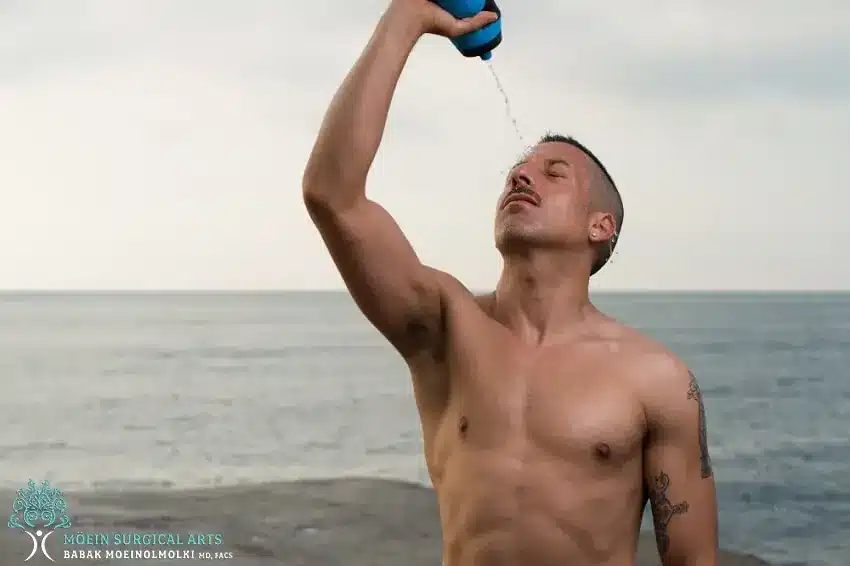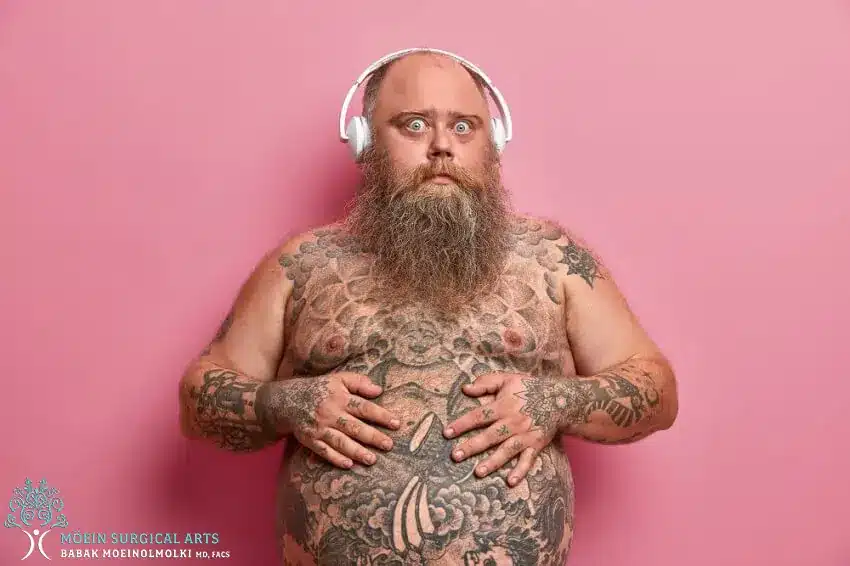
Excessive breast growth is a problem that nearly half of all men will face at some point in their lives. Some infants get the condition, and it can also happen to pubescent boys. Older men can even get gynecomastia, also commonly referred to as man boobs or moobs.
If you have excess breast growth, you may want to know more about it. More importantly, you want to know if treatment is available.
Here are 15 facts about gynecomastia you will definitely need to know before you seek out male breast reduction surgery, which is the permanent way to treat this psychologically damaging condition.
Growing breast tissue as a male does not mean there is something wrong with you. Many boys grow breasts during puberty. This is called pubertal gynecomastia.
When a boy goes through puberty, natural changes cause estrogen levels to spike. Estrogen is the hormone responsible for giving females their feminine features. Elevated female hormone levels can cause males to develop these features instead, like wide hips, a high-pitched voice, and enlarged breasts.
Some babies can get the condition, at least for a short time. This happens because the mother’s high levels of estrogen remain in the child’s blood for a short while following childbirth.
Men reaching middle age can also grow breasts. Testosterone begins to decline the older a man gets, which can lead to male breast growth.
So, you see, gynecomastia could be a natural product of puberty or age. Other men experience the condition because of medicines like antibiotics, anti-anxiety drugs, heart medicines, and treatments for AIDS.
Chemotherapy, steroids, illicit drugs, and some herbal products containing tea tree oil and lavender oil can also lead to or exacerbate male breast growth.

Gynecomastia is characterized by the growth of glandular tissue beneath the nipple. The tissue may feel like fat until you press on it, whereby you will notice glandular tissue in a disc-like shape. The only way to remove glandular growth is to have it removed surgically.
While you’re reading this, press on your areolas and feel for that firm glandular pad. If all you feel is mushy fat, you may not have gynecomastia at all. You may have what doctors refer to as pseudogynecomastia, which is an overgrowth of fat in the chest area. If that’s the case, you may find that losing weight is your best treatment for your male breasts.
Health problems like kidney disease, an overactive thyroid, or a cancerous tumor on a gland that controls the balance of hormones have all been shown to cause severe gynecomastia symptoms in males.
When you picture a man with breasts, you may imagine symmetrical overgrowth, but this isn’t always the case. Gynecomastia sometimes causes one breast to grow larger than the other or to become misshapen in one way or another.
Some men don’t experience any gynecomastia symptoms at all other than the expansion of skin on their chests. Other men may feel tenderness around the chest area, particularly around the nipple, while a few men may experience nipple discharge.
It’s helpful to note that male breast enlargement is often associated with health conditions like hyperthyroidism, cirrhosis of the liver, chronic kidney failure, obesity, and low testosterone levels.
If you are taking medications for these ailments, the medicines themselves could be to blame for glandular tissue growth. Even if you don’t seek gynecomastia treatment, you should seek medical care for any ailments that show up alongside the male breasts.

Gynecomastia will not threaten your health in most cases. Other than tenderness, few sufferers of the condition feel breast pain. There may be discomfort from wearing certain clothing, such as tight shirts that rub against sensitive or puffy nipples, for example.
But generally speaking, there is no harm in living with the condition. Unfortunately, many men with gynecomastia learn the hard way that there is a psychological price to pay for leaving excessive male breast growth untreated.
Excessive male breast growth can make sufferers feel like the odd man out. Even boys going through puberty may feel different or ostracized. Boys becoming men are trying to find themselves. That’s difficult to do when you feel as though you have been cursed with female-like breasts.
The boy may be teased or left out of some groups on account of the condition. Swimming and engaging in activities shirtless may terrify the poor young man.
Even adult men can feel self-conscious at the pool, in the locker room, or while getting intimate. Men who suffer from gynecomastia may choose dark or thicker clothing that hides their breasts. But every time he looks in the mirror, the excess tissue stares back.
Over time, gynecomastia can cause men to feel body dissatisfaction, reduced self-esteem, depression, and anxiety. Some men develop mental health conditions such as disordered eating and body dysmorphia, which could require psychological assistance.
Male breast cancer is incredibly rare. However, the effects of gynecomastia are similar to those of cancerous tumors. If you feel breast pain or see nipple discharge, get your chest examined by your general practitioner. A gynecomastia surgeon can also give you a diagnosis of breast cancer or gynecomastia, giving you peace of mind either way.
You may be surprised to learn that excessive male breast growth typically goes away with minimal treatment. When this happens, you won’t even know you had it before. In other words, most men go on to live normal lives, void of long-term complications from their previous gynecomastia condition.
This is good news and a big reason why many gynecomastia surgeons want pubescent-age boys to wait a couple of years before committing to treatment. Fluctuating hormones during puberty can eventually balance, and the breast tissue could subside.
If the glandular tissue remains, only male breast reduction surgery can effectively eliminate the problem entirely.
The cause of your gynecomastia problem may not be clear. An official diagnosis by a qualified gynecomastia surgeon can help you identify the origin of glandular growth.
In an effort to uncover the true cause, your doctor may ask the following questions:
Your doctor could test your blood for hormone imbalances. A physical examination can determine if tenderness or breast pain is present and if discharge results.

There are non-surgical and surgical medical treatments for gynecomastia.
For the non-surgery options, off-label medications work for some men. Prescriptions like raloxifene or tamoxifen can sometimes help to resolve the gynecomastia after a few months.
Your doctor may try switching medications or lowering your dose of current medicines to see if that takes care of the breast growth.
Testosterone therapy is another option that can work to boost your natural test levels. Testosterone replacement therapy (TRT) is used by millions of men and is administered via injections, patches, or skin gels.
Treating an underlying condition like malnutrition or hyperthyroidism can work as well.
For men with excess fat on their chests (pseudogynecomastia), sometimes reducing their body fat can eliminate the problem. Try to stay away from soy products and herbal remedies with tea tree oil, along with other estrogen-heavy foods, chemicals, and materials.
And pick up an exercise routine that is good for body fat burning, such as running or cycling. Aim for at least 150 hours per week of aerobic exercise to see if the breast growth resolves.
Gynecomastia surgery is one of those procedures that is customized according to the patient’s needs. For minor breast growth, only glandular excision is needed. This is performed during what is called male breast reduction surgery. Tissue excision refers to the cutting away of tissue. This could involve the removal of glandular tissue and/or excess skin.
Extreme cases of gynecomastia often include skin excision, as the breasts tend to expand beyond the sides of the chest. Once the glandular tissue and excess skin are removed, the chest will appear flatter and more masculine to better accommodate the ideal male shape.
Male breast reduction surgery can also involve liposuction to remove fatty tissue from the chest. Men suffering from pseudogynecomastia and glandular sufferers alike can have excess fat removed using lipo to make their chests flatter.
Gynecomastia surgery comes with a high safety rating and is able to permanently eliminate excessive breast growth.
Excessive male breast growth may be normal, but that doesn’t mean you have to live with it. Even if you don’t feel tenderness or breast pain, you may be suffering psychologically on account of your condition.
If you avoid certain situations because of your breast growth, wear certain clothing to hide it, and frequently feel down about how your chest looks, it’s time to improve your quality of life.
Schedule a consultation for male breast growth removal. A physical exam by an experienced gynecomastia surgeon can provide you with an official diagnosis and a potential recommendation for gynecomastia surgery. Imagine what life could be like without male breasts, then call: (310)694-4486.